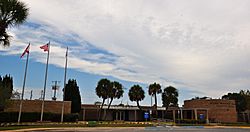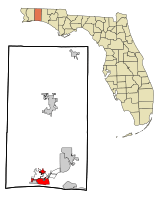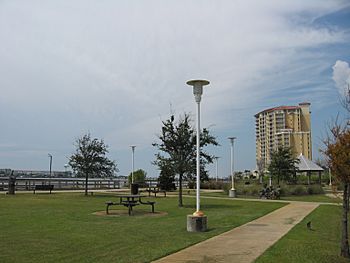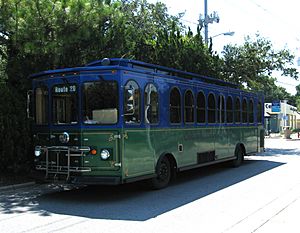Fort Walton Beach, Florida facts for kids
Quick facts for kids
Fort Walton Beach, Florida
|
||
|---|---|---|
| City of Fort Walton Beach | ||

Fort Walton Beach City Hall, September 2014
|
||
|
||
| Nicknames:
"The Emerald Coast", "The Camellia City", "The Sonic City"
|
||
| Motto(s):
"A City On The Move!"
|
||

Location in Okaloosa County and the state of Florida
|
||
| Country | ||
| State | ||
| County | ||
| Incorporated (city) | 1941 | |
| Area | ||
| • Total | 7.72 sq mi (20.00 km2) | |
| • Land | 7.64 sq mi (19.79 km2) | |
| • Water | 0.08 sq mi (0.20 km2) | |
| Elevation | 7 ft (2 m) | |
| Population
(2020)
|
||
| • Total | 20,922 | |
| • Density | 2,737.41/sq mi (1,056.99/km2) | |
| Time zone | UTC−6 (CST) | |
| • Summer (DST) | UTC−5 (CDT) | |
| ZIP Codes |
32547-32549
|
|
| Area code(s) | 850 | |
| FIPS code | 12-24475 | |
| GNIS feature ID | 0282710 | |
| Website | http://www.fwb.org | |
Fort Walton Beach, often referred to by the initialism FWB, is a city in southern Okaloosa County, Florida, United States. As of the 2020 U.S. census, the population was 20,922, up from 19,507 in 2010. It is a principal city of the Crestview−Fort Walton Beach−Destin, Florida Metropolitan Statistical Area.
Fort Walton Beach is a year-round fishing and beach resort community. Its busiest time of the year is the summer, causing a boost to the local economy because of seasonal human migration.
Contents
History
Prehistoric settlement of Fort Walton Beach is attributed to the mound building "Fort Walton Culture" that flourished from approximately 1100–1550 CE. It is believed that this culture evolved out of the Weeden Island culture. Fort Walton also appeared to come about due to contact with the major Mississippian centers to the north and west. It was the most complex in the north-west Florida region. The Fort Walton peoples put into practice mound building and intensive agriculture, made pottery in a variety of vessel shapes, and had hierarchical settlement patterns that reflected other Mississippian societies.
The first Europeans to set foot in what is now Okaloosa County and the Fort Walton Beach area were members of Álvar Núñez Cabeza de Vaca's party, who traveled by boat from what is now Panama City Beach, Florida in 1528 to Texas, "Then we set out to sea again, coasting towards the River of Palms. Every day our thirst and hunger increased because our supplies were giving out, as well as the water supply, for the pouches we had made from the legs of our horses soon became rotten and useless. From time to time we would enter some inlet or cove that reached very far inland, but we found them all shallow and dangerous, and so we navigated through them for thirty days, meeting sometimes Indians who fished and were poor and wretched people".
The area is described at "40 deaths a day" in a Spanish map dated 1566. In later English and French maps the area was noted as "Baya Santa Rosa" or "Bay St. Rose". A number of Spanish artifacts, including a portion of brigantine leather armor, are housed in the Indian Temple Mound Museum.
Contrary to popular belief, there is no documentary evidence of pirates using the area as a base of operations. Piracy was rampant in the Gulf of Mexico from pirates working out of Hispaniola, the Caribbean, and the Florida Keys. Notable raids occurred in 1683 and 1687 against the Spanish fort at San Marcos de Apalachee (by French and English buccaneers), a 1712 raid against Port Dauphin (now Alabama) by English pirates from Martinique, and the actions of the late 18th-century adventurer William Augustus Bowles, who was based in Apalachicola. Bowles was never referred to as "Billy Bowlegs" in period documentation; his Creek name was "Estajoca".
During the era of Spanish and English colonization, the area of what was to become Fort Walton Beach was noted in several journals but no worthwhile presence was established.
Early settlers of Walton County, Florida were the first to establish permanent settlements in what is now Fort Walton Beach (the area was originally named "Anderson"). Two of the first settlers were John Anderson and Andrew A. Alvarez, who received land plots in 1838. The name "Anderson" is noted on maps from 1838 to 1884. It was not until 1911 that the name "Camp Walton" appeared on Florida maps.
In 1861, Camp Walton was a Confederate Army camp, a fortified post, made up of the "Walton Guards", an independent Company of Florida Volunteer Infantry from Walton County. At this time, Okaloosa County did not yet exist. Walton County received its name from Col. George Walton, who served as secretary of West Florida during Andrew Jackson's governorship (1821–1822) and whose father, George Walton Sr., was the 56th signatory of the Declaration of Independence. He is also the namesake of Walton County.
Camp Walton was located between the Indian Temple Mound, now known as the Heritage Park and Cultural Center, and the Santa Rosa Sound, its mission was to protect the "Narrows" from Union ships. Although the "Walton Guards" did not see much action, they did keep busy by digging up prehistoric Indian remains buried in the Indian Temple Mound and displaying them at camp. The post was abandoned in August 1862, and the "Walton Guards" were assigned to reinforce the 1st Florida Infantry Regiment, with duty in the Western Theatre on the Tennessee front.
On April 11, 1879, John Thomas Brooks purchased at a public auction in Milton, Florida, 111 acres in Section 24, Township 2, Range 24 of Santa Rosa County, a portion of the property of Henry Penny whose heirs had failed to pay the taxes on the estate. This parcel on the Santa Rosa Sound became what is now downtown Fort Walton Beach.
The United States Post Office changed the official name on their cancellations from Camp Walton to Fort Walton on 1 March 1932.
The 1940 census counted 90 residents in Fort Walton. Fort Walton was incorporated by a state senate bill effective June 16, 1941.
The community's name was officially changed from Fort Walton to Fort Walton Beach on June 15, 1953, by agreement with the state legislature in Tallahassee, and incorporated a portion of Santa Rosa Island formerly known as Tower Beach. Tower Beach, named for a tall observation tower at the site which was later destroyed by a hurricane, had been an amusement area operated from 1928 by the Island Amusement Company by future-Fort Walton Beach mayor Thomas E. Brooks, with a boardwalk, casino, restaurant, dance pavilion, "40 modernly equipped beach cottages", and concession stands which was largely destroyed by fire on Saturday, March 7, 1942. Wartime supply restrictions prevented a reconstruction. This 875-acre parcel of Santa Rosa Island with three miles of Gulf frontage was conveyed to Okaloosa County on July 8, 1950, in an informal ceremony at the county courthouse in Crestview, Florida. The county paid the federal government $4,000 to complete the transaction, the result of the efforts of Congressman Bob Sikes. The portion of Santa Rosa Island transferred is now known as Okaloosa Island. The remaining Tower Beach summer cottages were removed after the 1955 tourist season as the new Okaloosa Island Authority redeveloped the site with a new hotel and casino. The government was changed to a city manager form.
A special census conducted in 1956 listed 9,456 residents, which grew to 11,249 by 1960.
The last of three county-owned buildings on Okaloosa Island was torn down on May 31, 1995. The buildings had originally housed the Okaloosa Island Authority and more recently the Okaloosa County Council on Aging. The 1.3-acre tract on the north side of Santa Rosa Boulevard was sold.
Geography
Fort Walton Beach is located at 30°25′13″N 86°37′00″W / 30.420199°N 86.616727°W (30.420199, −86.616727). According to the United States Census Bureau, the city has a total area of 21.3 km2 (8.2 sq mi), of which 19.3 km2 (7.5 sq mi) is land and 2 km2 (0.77 sq mi), or 9.26%, is water.
Climate
Fort Walton Beach experiences hot and very humid summers, generally from late May to mid-September. Autumns, from mid-September to early December, are generally warm. Winters are very short and mild, from mid-December to late February. Springs are warm, from late February to late May.
Fort Walton Beach averages 55.35 inches of rain each year. The wettest season is summer and the driest season is autumn, although flood season continues into autumn.
Snow and freezing rain are very rare. Freezing rain occurs about once every 5 to 10 years. Snow occurs about once every 10 to 15 years. The most recent measurable snowfall was on January 31, 1977, when about 1 inch (25 mm) fell in Fort Walton Beach, while 3 inches (76 mm) fell on Crestview, about 27 miles (43 km) inland. The most recent report of a trace of snow was on January 28, 2014. The last report of freezing rain was on February 11, 2010.
The Köppen climate classification subtype for this climate is humid subtropical climate (Cfa),
| Climate data for Fort Walton Beach, Florida (Destin–Fort Walton Beach Airport), 1991–2020 normals, extremes 1996–present | |||||||||||||
|---|---|---|---|---|---|---|---|---|---|---|---|---|---|
| Month | Jan | Feb | Mar | Apr | May | Jun | Jul | Aug | Sep | Oct | Nov | Dec | Year |
| Record high °F (°C) | 89 (32) |
81 (27) |
86 (30) |
89 (32) |
98 (37) |
102 (39) |
99 (37) |
100 (38) |
100 (38) |
93 (34) |
91 (33) |
85 (29) |
102 (39) |
| Mean maximum °F (°C) | 74.1 (23.4) |
74.3 (23.5) |
79.6 (26.4) |
83.3 (28.5) |
91.1 (32.8) |
94.5 (34.7) |
95.2 (35.1) |
95.2 (35.1) |
93.5 (34.2) |
88.7 (31.5) |
81.1 (27.3) |
77.2 (25.1) |
97.3 (36.3) |
| Mean daily maximum °F (°C) | 63.1 (17.3) |
65.8 (18.8) |
70.7 (21.5) |
76.2 (24.6) |
83.5 (28.6) |
88.9 (31.6) |
90.9 (32.7) |
90.6 (32.6) |
88.5 (31.4) |
80.9 (27.2) |
72.1 (22.3) |
65.6 (18.7) |
78.1 (25.6) |
| Daily mean °F (°C) | 54.2 (12.3) |
56.9 (13.8) |
62.2 (16.8) |
68.1 (20.1) |
75.8 (24.3) |
81.5 (27.5) |
83.6 (28.7) |
83.2 (28.4) |
80.5 (26.9) |
72.1 (22.3) |
62.6 (17.0) |
56.6 (13.7) |
69.8 (21.0) |
| Mean daily minimum °F (°C) | 45.3 (7.4) |
47.9 (8.8) |
53.6 (12.0) |
60.1 (15.6) |
68.0 (20.0) |
74.1 (23.4) |
76.2 (24.6) |
75.8 (24.3) |
72.4 (22.4) |
63.2 (17.3) |
53.0 (11.7) |
47.5 (8.6) |
61.4 (16.3) |
| Mean minimum °F (°C) | 28.6 (−1.9) |
33.2 (0.7) |
38.8 (3.8) |
49.5 (9.7) |
57.9 (14.4) |
69.3 (20.7) |
72.2 (22.3) |
72.5 (22.5) |
64.5 (18.1) |
49.0 (9.4) |
38.7 (3.7) |
35.0 (1.7) |
27.1 (−2.7) |
| Record low °F (°C) | 20 (−7) |
23 (−5) |
30 (−1) |
41 (5) |
49 (9) |
62 (17) |
66 (19) |
66 (19) |
55 (13) |
42 (6) |
30 (−1) |
22 (−6) |
20 (−7) |
| Average precipitation inches (mm) | 4.52 (115) |
4.96 (126) |
4.70 (119) |
4.55 (116) |
3.22 (82) |
4.70 (119) |
5.77 (147) |
6.08 (154) |
5.18 (132) |
2.82 (72) |
4.13 (105) |
4.72 (120) |
55.35 (1,406) |
| Average precipitation days (≥ 0.01 in) | 10.0 | 9.4 | 8.7 | 7.9 | 6.4 | 9.7 | 11.2 | 12.4 | 8.2 | 6.1 | 8.9 | 10.6 | 109.5 |
| Source: NOAA (mean maxima and minima 2006–2020 | |||||||||||||
Transportation
Airports
Nearby Destin-Fort Walton Beach Airport (airport code VPS) serves Fort Walton Beach, as well as Valparaiso, Florida. Airlines that currently serve Destin-Fort Walton Beach Airport are Allegiant Airlines, American Eagle, Southwest, Delta Air Lines, and Delta Connection. They provide non-stop service to Atlanta, Cincinnati, Charlotte, Dallas, Fort Lauderdale, Houston, Las Vegas, Knoxville, Memphis, Oklahoma City, and St. Louis.
Okaloosa County Transit provides public transportation throughout Fort Walton Beach as well as Okaloosa County. Its main stop and transfer location is Uptown Station located on State Road 85, a little over 1 mile north of US 98.
Major highways
State Road 189 is a north–south highway from State Road 85 to US 98 in downtown Fort Walton Beach. State Road 85 is a north–south highway that leads north 27 mi (43 km) to Crestview, the Okaloosa County seat (also along Interstate 10), and ends at US 98 in downtown Fort Walton Beach. US 98 is an east–west highway, which runs through downtown Fort Walton Beach. The Brooks Bridge over the Santa Rosa Sound connects downtown Fort Walton Beach with Okaloosa Island, which is along the route of US 98. US 98 leads east 9 mi (14 km) to Destin and west 41 mi (66 km) to Pensacola.
Demographics
| Historical population | |||
|---|---|---|---|
| Census | Pop. | %± | |
| 1950 | 2,463 | — | |
| 1960 | 12,147 | 393.2% | |
| 1970 | 19,994 | 64.6% | |
| 1980 | 20,829 | 4.2% | |
| 1990 | 21,471 | 3.1% | |
| 2000 | 19,973 | −7.0% | |
| 2010 | 19,507 | −2.3% | |
| 2020 | 20,922 | 7.3% | |
| U.S. Decennial Census | |||
2010 and 2020 census
| Race | Pop 2010 | Pop 2020 | % 2010 | % 2020 |
|---|---|---|---|---|
| White (NH) | 14,245 | 13,777 | 73.03% | 65.85% |
| Black or African American (NH) | 2,331 | 2,284 | 11.95% | 10.92% |
| Native American or Alaska Native (NH) | 104 | 65 | 0.53% | 0.31% |
| Asian (NH) | 618 | 828 | 3.17% | 3.96% |
| Pacific Islander or Native Hawaiian (NH) | 54 | 20 | 0.28% | 0.10% |
| Some other race (NH) | 31 | 122 | 0.16% | 0.58% |
| Two or more races/Multiracial (NH) | 586 | 1,382 | 3.00% | 6.61% |
| Hispanic or Latino (any race) | 1,538 | 2,444 | 7.88% | 11.68% |
| Total | 19,507 | 20,922 |
As of the 2020 United States census, there were 20,922 people, 9,246 households, and 5,195 families residing in the city.
As of the 2010 United States census, there were 19,507 people, 8,657 households, and 4,950 families residing in the city.
Notable people
- John C. Acton, retired United States Coast Guard rear admiral who serves as the director of operations coordination for DHS
- Aric Almirola, NASCAR driver with three Cup Series wins
- Glen Coffee, running back for Alabama Crimson Tide and in NFL; San Francisco 49ers drafted Coffee with 74th overall pick of 2009 NFL draft
- Richard Covey, astronaut
- Bud Day, retired U.S. Air Force colonel, Marine Corps, Army and Air Force veteran, Vietnam prisoner of war, Medal of Honor and Air Force Cross recipient
- Jason Elam, NFL kicker, two-time Super Bowl champion with Denver Broncos
- Scott Fletcher, MLB baseball infielder
- Scott Frank, screenwriter
- Matt Gaetz, American politician
- Shane Gibson, internationally known heavy metal guitarist, most notable as touring guitarist for Korn
- E. G. Green, NFL wide receiver, Indianapolis Colts
- D. J. Hall, Alabama and NFL wide receiver
- Edward L. Hubbard, retired Air Force officer, author, artist, motivational speaker and Vietnam Prisoner of War
- Michael Johnson, South Carolina politician
- Nancy Kenaston, journalist, public relations director, court reporter at Nuremberg trials
- Rick Malambri, actor
- Brian Marshall, bass player for rock bands Creed and Alter Bridge
- Demetria McKinney, actress
- Maurice McLaughlin, politician
- Lonnie R. Moore, Korean War Double Ace
- Matt Moore, pitcher for the Texas Rangers
- Carolyn Murphy, internationally acclaimed model (born in Panama City, Florida)
- Preston Shumpert, basketball player, Syracuse forward and guard
- Akeem Spence, NFL (Miami Dolphins) defensive tackle, University of Illinois defensive tackle
- Joe Stanley, retired U.S. Air Force colonel, commander of Eglin Air Force Base during 1950s
- Danny Wuerffel, 1996 Heisman Trophy winner for Florida and quarterback for New Orleans Saints
- Mike James (baseball) (born 1967), Major League Baseball pitcher for the California Angels, St. Louis Cardinals, and the Colorado Rockies
Economy
The economy of Fort Walton Beach is driven by two primary factors: tourism and the military. There are two major Air Force bases which border Fort Walton Beach. Hurlburt Field is home to Headquarters, Air Force Special Operations Command (AFSOC), the 1st Special Operations Wing, and the Joint Special Operations University. Eglin AFB is home to the Air Force Materiel Command's Air Force Life Cycle Management Center's Armament Directorate and the 96th Test Wing, Air Combat Command's 53rd Wing, and Air Education Training Command's 33rd Fighter Wing. Eglin is geographically one of the largest Air Force bases at 724 square miles (1,880 km2), and thus home to joint exercises, and missile and bomb testing. For example, the 'Massive Ordnance Air Blast' or 'Mother of All Bombs' (MOAB) was first tested at Eglin AFB on March 11, 2003.
There is support industry in the area that benefits from the presence of the bases, including military contractors and the service industry.
The tourism industry is seasonal, with summer being the primary season, and a smaller peak season during spring break. The area also boasts a large snowbird population, which includes the Fort Walton Beach Snowbird Club. The Billy Bowlegs Pirate Festival is held annually in June.
Top employers
According to Fort Walton Beach's 2010 Comprehensive Annual Financial Report, the top employers in the city were:
| # | Employer | Employees |
|---|---|---|
| 1 | Eglin Air Force Base | 16,476 |
| 2 | Hurlburt Field | 11,171 |
| 3 | Okaloosa County School District | 3,278 |
| 4 | Okaloosa County | 1,383 |
| 5 | Fort Walton Beach Medical Center | 1,305 |
| 6 | DRS Technologies | 875 |
| 7 | InDyne | 786 |
| 8 | Northwest Florida State College | 763 |
| 9 | ResortQuest | 750 |
| 10 | BAE Systems | 700 |
Sister cities
 Quezon City, Philippines (since October 1977)
Quezon City, Philippines (since October 1977)
See also
 In Spanish: Fort Walton Beach para niños
In Spanish: Fort Walton Beach para niños




